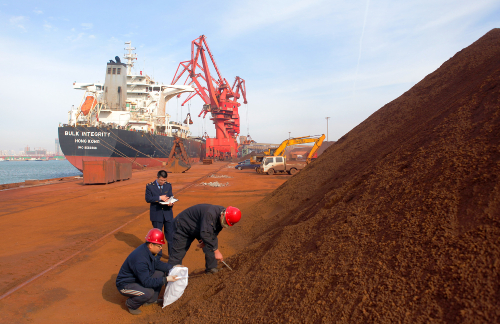|
 |
|
Chinese inspectors take samples from iron ore imported from Australia in Rizhao Port of east China's Shandong Province on November 25, 2014 (XINHUA) |

The final signing of the Free Trade Agreement (FTA) between Australia and China on June 18 marks the end of discussions and negotiations that have been ongoing since the mid-2000s. While nowhere near as epic as the 14-year period during which China was working on entering the World Trade Organization up to the time of its entry in 2001, for Australia and its surrounding region at least, this is a significant moment.
Before now, China's bilateral free trade deals have been with relatively small economies such as Iceland, Switzerland and New Zealand. Australia is a far larger and more complex economy than any of those, so the stipulations in the agreement will be of great interest to, for instance, some of the other parties currently considering similar arrangements with China--the European Union (EU) in particular.
In the meantime, however, Australia does enjoy a strategic advantage. Of the developed economies in the G20, it alone possesses a specific trade agreement with China devoted to encouraging the flow of goods and services between the two economies.
A necessary move
This has added significance for Australia because, for the first time in a generation, it is undergoing a period of austerity and economic uncertainty, having been the sole Western developed country to make it through the great financial crisis from 2008 with no major blip in its growth record. From 1991 onwards, it has enjoyed continuously positive GDP growth. Australians under the age of 30 can barely remember a period when the country was not expanding its economic size.
In recent years, this growth has largely been fueled by burgeoning links with China. From the early 2000s, the demand for Australian resources, in particular iron ore, led to a boom in western Australia where most of the major mines are located, creating, on one account, over 27,000 good-quality jobs, and making mine owners like Andrew Forrest and Gina Reinhardt immensely wealthy.
The slowing Chinese growth rate in the last two years, and the fall in demand owing to excess capacity, means that iron ore prices have simply collapsed. [Once standing at over $117 a ton, they now come in at less than $50.] Government revenues have been dramatically impacted. Western Australia alone faces a 2 billion Australian dollars ($1.55 billion) shortfall in its budget next year, if the current situation persists.
For a country that has become accustomed to constant growth, one of the world's best healthcare and public welfare systems, and high employment, the current situation is sobering. The EU and the United States, formerly Australia's largest trading partners, have long since dropped back. China has sat as the major source of Australian trade since 2010, with Japan coming in second. And while EU and the United States investment into Australia is still immensely important, Chinese companies and individuals are also increasingly figuring here.
This brings us to the context in which the FTA has been signed. The new underlying narrative promoted by this deal is that beyond exporting mining resources north to China, Australia wants to position itself for a more diverse relationship. That has been clear for some time. Australia enjoys some advantages over other competitors like the United States or Germany. It occupies roughly the same time zone and belongs to the same region. And its relationship with China politically has always been less complex than that of the EU or America. It is neither a country with a record as a colonizer of China, nor a superpower. In terms of perception, those are two big assets.
The problem is that Chinese understanding of the attributes of the Australian economy beyond mining, and the depth of engagement and willingness of Australian business to engage economically with China are both currently limited, in different ways. Most Chinese would appreciate what Australia has to offer tourist-wise, and many would see the benefits of attending universities there. Some might see it as a potential source of food exports, and of property investment. But for a sustainable and dynamic relationship, things need to go beyond this. In the end, Australia needs its economic strengths to be better understood in China.
A similar complaint could be made about Australian companies. A currency swap agreement was signed in 2013, under which Australia companies could invoice directly in Chinese renminbi rather than go through an intermediary currency like the U.S. dollar, thus saving in exchange rate costs. A survey undertaken a few weeks after this was implemented showed, in fact, that very few Australian companies were either availing themselves of the benefits of this deal, or, more worryingly, even knew of its existence or why it might be of use to them.
Vast potential
There are plenty of Australian companies with a sophisticated and deep understanding of the opportunities existent in China at present. ANZ bank and Westpac, for instance, spring to mind. Australian universities like the University of Monash, the University of Melbourne or the University of Sydney have extensive research links with China, running from fellow universities to companies there. Additionally, Australia is home to a thriving and successful population of ethnic Chinese, some long established (the first Chinese started to migrate in large numbers to Australia during the gold rushes of the mid-19th century), and many of whom either engage in or assist with bilateral trade.
The FTA will at the very least provide some opportunity and impetus for Australian companies who have not thought about dealing with China to now have a look. The main sectors that receive the most attention are healthcare, agribusiness and services. In all of these, there is great potential. Australia spends about 10 percent of its GDP on healthcare, compared to the United States which comes in at 18 percent. But it has some of the best quality and most efficiently provided healthcare in the world, with an excellent primary care system, and good medical insurance. It also has very strong research capacity in the kinds of diseases a country like China will increasingly experience, being as it is, a country with urban centers that have already reached developed GDP levels.
As for agribusiness, the fit is natural, with Chinese consumers already keen on Australian meat. Livestock can, potentially, be exported to China, subject to welfare and quality provisions. The expansion of trade in other foodstuffs would be natural, in view of the increasingly diverse diet and demand amongst Chinese consumers for various good-quality foodstuffs, many of which will be imported.
Services, however, is by far the most exciting sector. Australia is a strong service-led economy, with about 80 percent of all economic activity taking place in finance, legal and professional services and other areas. Sydney and Melbourne are finance centers, with major funds and banks. Till now, Australia's engagement with China in the role of service provider has been highly limited. The FTA offers an opportunity for Australians to start thinking of themselves much more as service sector partners rather than exporters of raw materials.
There are plenty of other provisions in the agreement--in tourism, for instance, allowing Australian companies to operate in China servicing the increasing number of international and domestic tourists. Education provision is another major area, and the most important of that Australia's service sector exports. Australian universities under the FTA should find it easier to open up in China and undertake cooperation there.
The FTA may well be signed, but this should only be the start. It offers a broad framework which should help both countries diversify their economic relationship. From an Australian standpoint, it also offers an opportunity for the Chinese to think about and understand the possibilities now within their grasp Down Under, and see their antipodean counterpart as a more complex and multifaceted partner. But without companies taking up the challenge of working more in China, the FTA will just be a piece of paper or an abstract agreement. The core challenge for government and enterprise in Australia now is to quickly develop a generation of China-literate and engaged business people who can develop what the FTA lays out. That will be the theme of the next couple of years.
The author is an op-ed contributor to Beijing Review and executive director of the China Studies Center at the University of Sydney
Copyedited by Eric Daly
Comments to liuyunyun@bjreview.com
|
